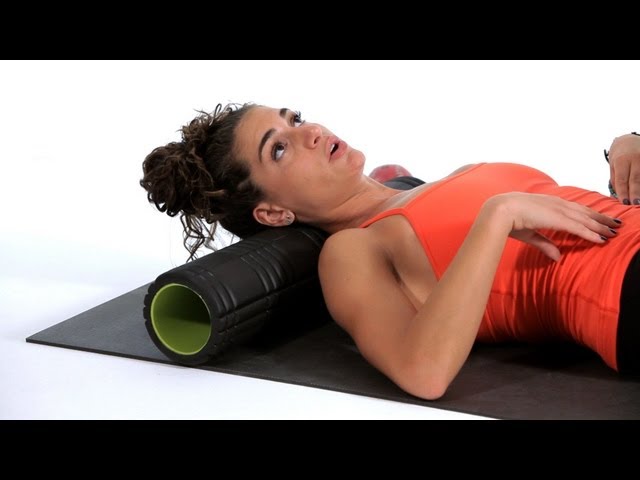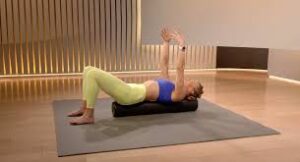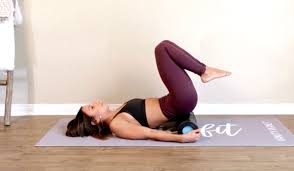

I am sure you all are eager to learn how to fix neck posture with foam roller. Foam roller is a tiny piece of exercise equipment that is primarily used by athletes and gym enthusiasts.
As I was suffering from forward head posture for a very long time, I was eager to find a solution to my issue. One such method that I did try (on the advice of my buddies) was the use of a foam roller.
Here is how my experience was with special regards to using a foam roller to fix my nerd neck:
Points Covered in this Article:
1) What is a Foam Roller?
2) How I Developed Vulture Neck Posture?
3) How I Fixed My Neck Posture with Foam Roller?
- Discovering the Problem
- Rolling Out the Kinks
- Targeting the Neck
- Consistency is Key
- The Final Results
4) FAQs on Foam Roller to Fix Vulture Neck Posture
5) My Conclusive Analysis
What is a Foam Roller?
A foam roller is a simple yet effective cylindrical tool made primarily from dense foam materials.
You will often spot them in gyms, physical therapy clinics, and even in people’s homes, highlighting their widespread popularity and usefulness.
Designed in various sizes and densities, foam rollers cater to a broad range of preferences and needs.
The basic structure of a foam roller consists of a solid or hollow core enveloped by foam, which can vary in firmness.
Some rollers feature a smooth surface, while others have textured patterns like ridges or bumps.
These different textures are crafted to provide varying levels of pressure and stimulation, allowing users to choose what feels most comfortable and effective for them.
Foam rollers also come in diverse lengths and diameters.
Shorter rollers are typically more portable and better suited for targeting specific areas of the body, whereas longer ones offer greater stability and can address larger muscle groups more efficiently.
The choice of size often depends on the intended use and the individual’s personal comfort.
The materials used in manufacturing foam rollers include polyethylene, EVA foam, and expanded polypropylene, each offering distinct levels of durability and firmness.
This variety ensures that there’s a suitable option for everyone, whether you are a beginner looking for something gentle or an experienced user seeking a more intense experience.
How I Developed Vulture Neck Posture?
You know how people often say that bad habits sneak up on you? Well, that is exactly how I ended up with a vulture neck posture.
It was not a sudden epiphany where I woke up one day and thought, “Hey, let’s try out this hunched-over look.”
No, it was more of a gradual, unintentional masterpiece of poor posture that developed over years of doing one thing—birdwatching.
Yes, you heard that right.
My fascination with our feathered friends turned into a daily ritual that involved hours of peering through binoculars, craning my neck forward to get a closer look at those elusive warblers and finches.
What started as a harmless hobby quickly transformed into a neck-straining marathon, as I tilted my head forward for hours on end, trying to spot every last bird in the trees.
Little did I know, this innocent pastime was slowly molding my posture into that of the very birds I was so obsessed with watching.
I used to be proud of my ability to identify a bird by its song alone, but now, I am left wondering if the constant forward lean of my neck was worth it.
I mean, I became so engrossed in watching the skies that I forgot to watch my own posture.
My neck began to jut out like a vulture, and before I knew it, I was sporting the very posture I admired in my avian friends—minus the wings, of course.
It was not until a friend pointed out that I was beginning to resemble a bird of prey in more ways than one that I realized something had to change.
The irony was too rich: in my quest to admire the perfect poise of birds, I had managed to develop the posture of one myself—though not in the way I had hoped.
>>> Want to Learn How I “Fixed My Tech Neck” at Home??? Click Here to Find Out! <<<
This is How I Use a Foam Roller
I tried a few tricks and techniques using a foam roller. As I was habitual of exercising at the gym, I was able to master the right technique for correcting my bad neck posture.
So, here is what I did:
Discovering the Problem:
I did not realize how bad my neck posture had become until one day I caught a glimpse of myself in a mirror.
My neck was leaning forward like I was perpetually trying to peer over an imaginary fence.
It was not just about aesthetics, either—I started feeling the tension creeping up my neck and shoulders. That is when I decided it was time to do something about it.
Enter: the foam roller.
Rolling Out the Kinks:
I’d heard about foam rollers mainly as a tool for muscle recovery, but I soon discovered they could do wonders for posture correction too.
The first method I tried was the Thoracic Extension Stretch.
I placed the foam roller horizontally under my upper back, just below the shoulder blades, and slowly leaned back over it, letting gravity do its work.
This simple motion helped release the tightness in my upper back, allowing my chest to open up and my neck to naturally align better with my spine.
Research shows that thoracic spine mobility is crucial for maintaining good posture, and foam rolling can significantly improve it.
According to a study published in the Journal of Sports Rehabilitation, foam rolling can enhance thoracic spine extension, which in turn helps in correcting forward head posture.
Targeting the Neck:
Next, I focused on my neck directly. For this, I used a technique called the Suboccipital Release.
I laid down on my back with the foam roller positioned under my neck, right at the base of my skull.
Gently, I rolled my head from side to side, massaging the suboccipital muscles—those pesky little guys that tighten up when your head juts forward.
This not only felt amazing but also helped relieve the tension that was contributing to my bad posture.
Scientific evidence supports this too.
A study in the Journal of Bodywork and Movement Therapies found that foam rolling the suboccipital muscles can effectively reduce neck pain and improve posture by releasing tension and improving muscle function.
Consistency is Key:
Of course, none of these methods would have worked if I had not made them a regular part of my routine.
I committed to using the foam roller at least three times a week, and gradually, I started noticing real improvements.
My neck was no longer jutting out like a turtle’s, and the constant tension in my shoulders began to melt away.
The Final Results:
After a few weeks of consistent foam rolling, I could see and feel a difference.
My neck felt stronger, my posture was noticeably better, and best of all, the discomfort I would been experiencing was practically gone.
The foam roller, once a mystery to me, had become my go-to tool for maintaining a healthy, upright posture.
In conclusion, fixing my neck posture with a foam roller was not just about rolling away the kinks—it was about reclaiming my posture and, by extension, my confidence.
If I can do it, so can you!
How I Use a Foam Roller – My Exact Strategy:
Dealing with “text neck”—the strain caused by prolonged device use—was a challenge I faced. Incorporating a foam roller into my routine provided significant relief.
Here is a step-by-step guide based on my experience:
1. Understanding Text Neck:
- Definition: “Text neck” refers to the neck pain and strain resulting from looking down at your phone, tablet, or computer for extended periods. Over time, this can cause poor posture, stiffness, and even headaches.
2. Choosing the Right Foam Roller:
- Selection: A medium-density foam roller is best for neck and upper back relief, as it effectively releases muscle tension without causing excessive discomfort.
3. Preparing for the Exercises:
- Setup: Find a comfortable space on the floor with enough room to move freely.
- Warm-Up: Perform gentle neck stretches, such as tilting your head from side to side and forward and backward, to prepare your muscles.
4. Foam Roller Exercises:
Suboccipital Release:
- Lie on your back with knees bent and feet flat.
- Place the foam roller beneath the base of your skull.
- Slowly nod your head up and down (“yes” motion) for 30 seconds.
- Turn your head side to side (“no” motion) for another 30 seconds.
- This technique targets the suboccipital muscles, helping relieve tension at the skull’s base. According to Dani Winks Flexibility, this release is particularly useful for reducing headaches and stiffness in the upper neck.
Upper Back (Thoracic Spine) Mobilization:
- Position the foam roller horizontally under your upper back, near the shoulder blades.
- Support your head with your hands, keeping elbows pointed forward.
- Lift your hips slightly off the ground and slowly roll from your upper to mid-back.
- Do this for 30-60 seconds to release tension in the thoracic spine. Amplify Chiropractic explains that this movement improves posture by reducing tightness in the upper back and shoulders.
Lateral Neck Release:
- Lie on your side with the foam roller positioned under the side of your neck.
- Gently tilt your head toward the roller to apply light pressure.
- Slowly nod your head up and down for 30 seconds.
- Repeat on the other side.
- This exercise targets the sternocleidomastoid muscle, a common site of tension. Steel Supplements suggests this release helps alleviate neck stiffness and improves mobility.
5. Post-Exercise Stretching
Neck Stretch:
- Sit or stand upright.
- Gently tilt your head to the right, bringing your ear toward your shoulder.
- Hold for 20-30 seconds, then repeat on the left side.
- This stretch lengthens the neck muscles, improving flexibility. According to The Everygirl, performing this stretch regularly can help prevent future text neck symptoms.
6. Consistency and Maintenance
- Routine: Perform these foam rolling exercises 3-4 times a week for optimal results.
- Ergonomics: Adjust your screen height to eye level, take frequent breaks, and avoid prolonged device use to prevent recurrence.
By consistently following this foam rolling regimen, I experienced noticeable relief from text neck symptoms.
The key is regular practice and ensuring proper posture throughout the day.
FAQs on Foam Roller to Fix Vulture Neck Posture
Q-1: How does using a foam roller help improve neck posture?
A-1: A foam roller targets muscles in the upper back, shoulders, and thoracic spine, areas that often become tight and contribute to poor neck posture. By releasing tension and improving muscle flexibility in these regions, foam rolling indirectly supports better cervical alignment, helping to reduce the forward head position associated with poor neck posture.
Q-2: What is the correct technique for using a foam roller to fix neck posture?
A-2: To use a foam roller effectively for neck posture:
- Position the foam roller horizontally under your upper back, near the base of your neck.
- Gently roll up and down the upper thoracic spine, avoiding direct pressure on the neck vertebrae.
- Pause on tight or sore spots to allow muscles to release.
- Perform for 1-2 minutes, focusing on slow, controlled movements.
- Avoid excessive pressure or rapid rolling to prevent strain.
This technique helps improve mobility and reduces muscle tightness affecting neck posture.
Q-3: Can foam rolling the neck itself be beneficial or is it risky?
A-3: Direct foam rolling on the neck is generally discouraged due to the delicate structure of cervical vertebrae and the risk of injury. As per bestforwardheadposturefix.com, “Instead, foam rolling the upper back and shoulders is safer and can indirectly relieve neck tension.” For direct neck muscle release, manual therapy or targeted stretching is preferable.
Q-4: How frequently should foam rolling be incorporated to see improvements in neck posture?
A-4: Incorporating foam rolling into your routine 3–4 times per week can lead to noticeable improvements in muscle flexibility and posture over time. Consistency is key, and pairing foam rolling with strengthening exercises for postural muscles enhances results.
Q-5: Are there specific foam roller types or sizes better suited for addressing neck posture?
A-5: A medium-density foam roller about 12–18 inches long is ideal for targeting the upper back and shoulders. Softer rollers may not provide enough pressure, while very firm rollers could cause discomfort. Using a roller with textured surfaces can also help release muscle knots more effectively.
Q-6: Can foam rolling be combined with other therapies to fix neck posture?
A-6: Yes, combining foam rolling with stretching, strengthening exercises, and ergonomic adjustments creates a comprehensive approach to fixing neck posture. Foam rolling prepares the muscles by releasing tension, making stretching and strengthening exercises more effective in promoting proper alignment and reducing forward head posture.
My Conclusive Analysis
In summary, my journey to find the best forward head posture fix with a foam roller was nothing short of transformative.
What began as a simple experiment to alleviate the discomfort caused by forward head posture turned into a regular practice that has significantly improved my overall well-being.
The foam roller, with its versatility and ease of use, became an indispensable tool in my routine.
By consistently targeting the thoracic spine and suboccipital muscles, I was able to release the tension that had been pulling my neck out of alignment for years.
The results speak for themselves: not only did my neck posture improve, but I also regained the confidence that had slowly ebbed away with my deteriorating posture.
While it took dedication and consistency, the payoff was more than worth it.
So, if you are struggling with neck posture like I was, consider giving the foam roller a try.
It may just be the key to reclaiming not only your posture but also your peace of mind.
References:


